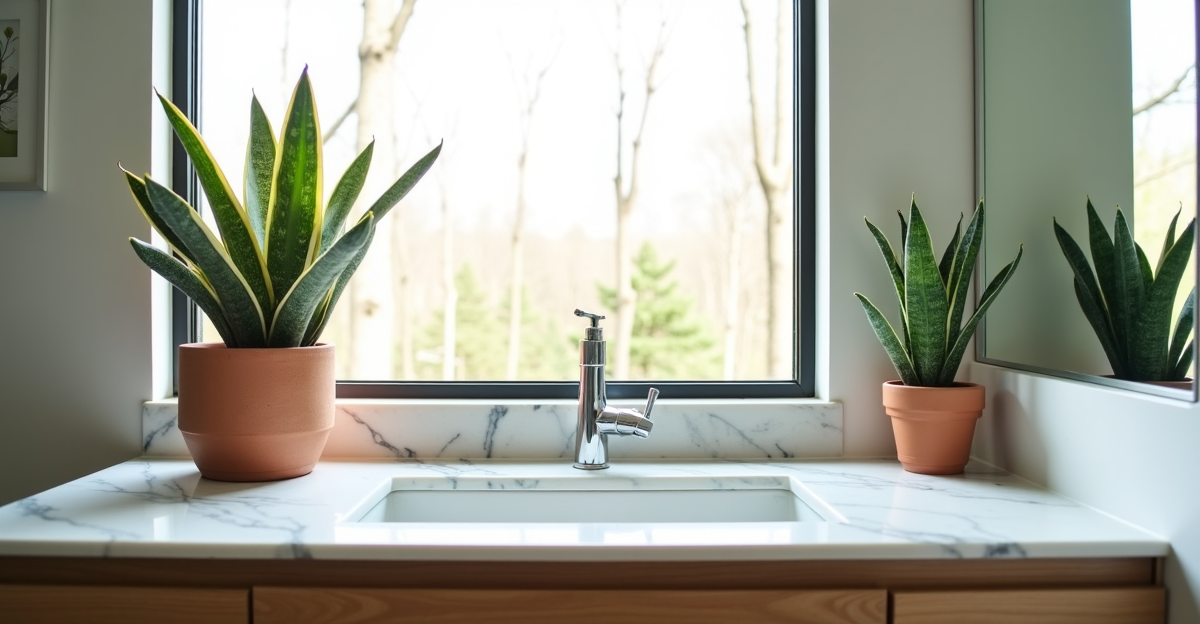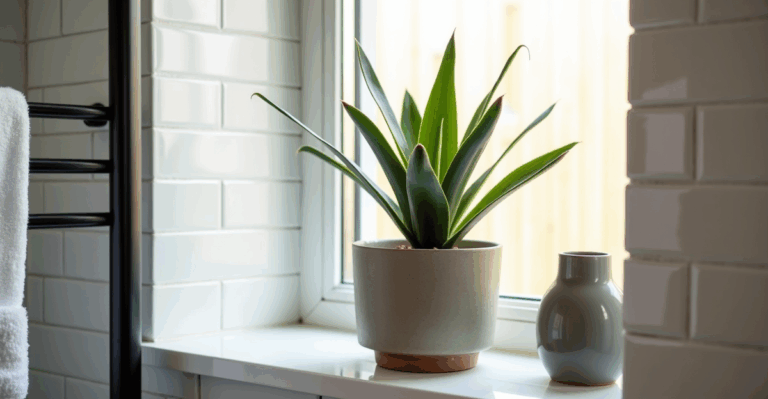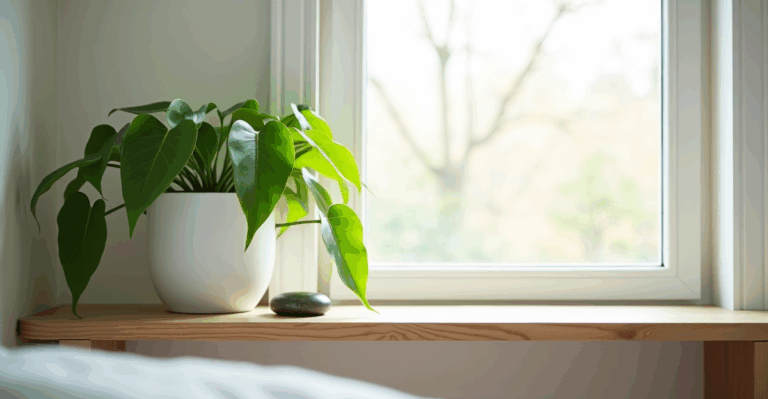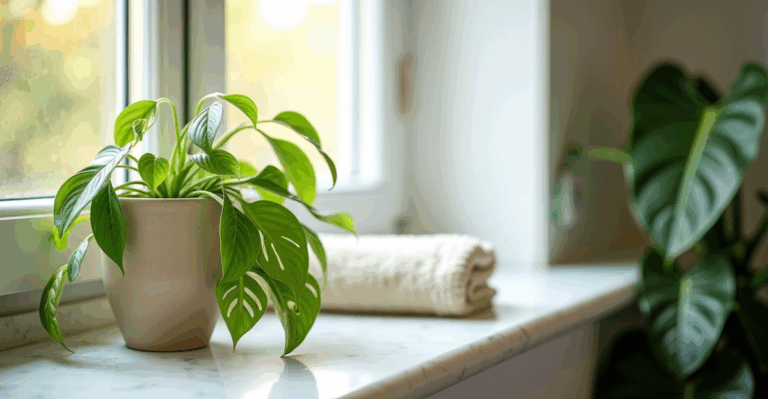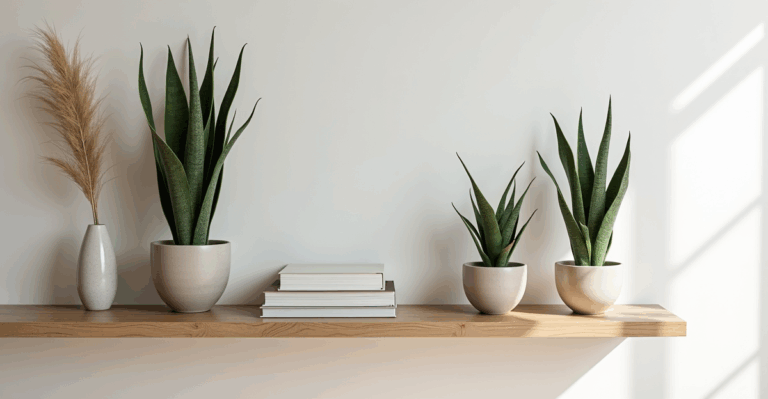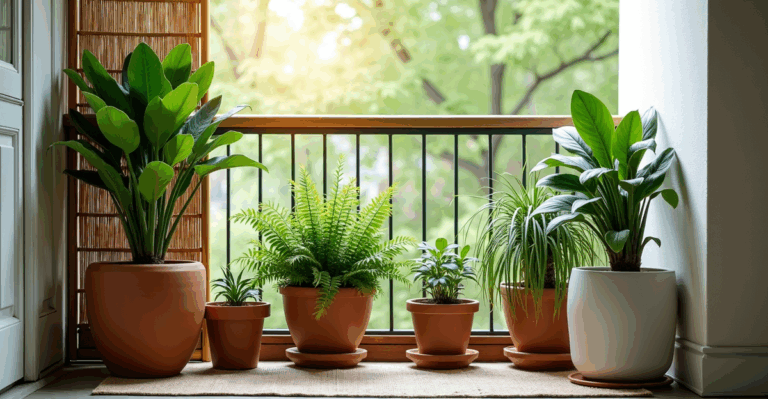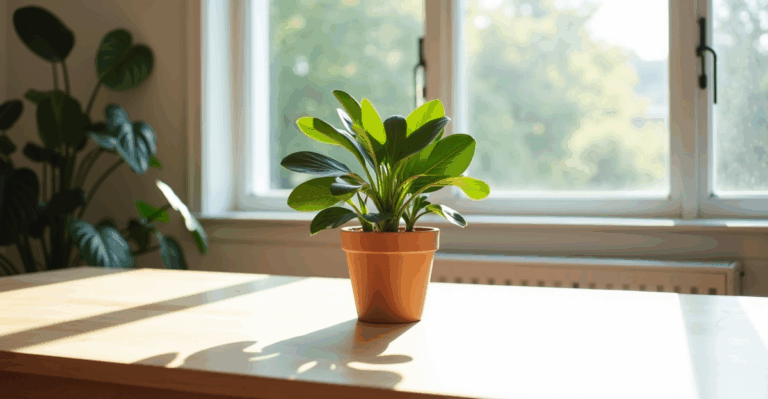Snake Plants That Actually Thrive in Your Steamy Bathroom (And Why Your Heavy Planter Is Failing You)
That moment when you open the bathroom mirror after a shower and see your snake plant’s leaves beaded with condensation? It’s a win. You’ve created a little jungle oasis where the humidity actually helps the plant. But then you glance at the heavy ceramic pot, slick with moisture, and wonder: Is this thing crushing my vanity? Will it crack when the steam hits it? Why does my plant look a little sad even though it’s getting all this moisture? You’re not alone. We’ve seen it a thousand times. The problem isn’t the snake plant—it’s the planter. And the wrong snake plant variety for your bathroom’s unique conditions.
Snake plants (Sansevieria) are the classic “forgiving” plant, but “forgiving” doesn’t mean “unfussy.” In a bathroom, humidity is your friend, but it’s a double-edged sword. Too much and poor drainage equals root rot. Too little and the plant might look less vibrant. The wrong variety, paired with a heavy, non-breathable pot, turns a low-maintenance star into a maintenance headache. We’ve tested dozens in real bathrooms—east-facing (bright, indirect), north-facing (dimmest), and even those with a single south-facing window that gets fierce afternoon sun for 30 minutes. The key isn’t just which snake plant, but how it interacts with your bathroom’s light, humidity, and the planter you’ve chosen.
Not All Snake Plants Are Created Equal for Bathrooms
Let’s shatter the myth: All snake plants are identical in their bathroom needs. They’re not. The differences in leaf structure, growth habit, and moisture tolerance matter immensely. Here’s what to prioritize:
- Leaf Thickness & Growth Habit: Thicker leaves (like ‘Laurentii’) handle humidity better but need a bit more light to stay vibrant. Thinner leaves (like ‘Futura Superba’) can tolerate slightly lower light but are more prone to root rot if overwatered. Short, compact varieties (like ‘Hahnii’) are perfect for small shelves or vanity tops.
- Light Tolerance: Bathroom light varies wildly. An east-facing window (bright, indirect light for 3-4 hours) is ideal. A north-facing window (low, consistent light) is doable with the right variety but requires extra caution. A south-facing window (intense sun) is a risk—only for ‘Laurentii’ or ‘Hahnii’ with a sheer curtain, and only if you monitor closely for scorch.
- Moisture Needs: Even in humidity, snake plants need their roots to dry out between waterings. The bathroom’s steam doesn’t replace the need for proper drainage. Varieties with thicker, more upright growth generally tolerate slightly more moisture than sprawling types.
The Top 3 Snake Plant Varieties for Bathroom Bliss (Backed by Real Care)
-
Sansevieria ‘Hahnii’ (Bird’s Nest Snake Plant): Your ideal low-light, compact bathroom companion.
- Why it wins: This little powerhouse hugs the soil, grows slowly, and loves high humidity. Its short, dense rosette fits perfectly on a small shelf, vanity, or even a narrow windowsill. It tolerates lower light (north-facing bathroom? No problem) better than most. Its thick, rounded leaves hold moisture well without needing constant dampness.
- Care Reality Check: Water only when the top 2-3 inches of soil feel dry (use your finger—don’t guess!). In a steamy bathroom, this might be every 3-4 weeks in winter, but only if the soil is dry. Overwatering is the #1 killer, even here. Flush the pot with plain water every 2-3 months to prevent mineral buildup from hard water (a common bathroom issue).
- Bathroom Fit: Perfect for small spaces (bathroom shelves, top of a cabinet, beside the sink). Its compact size means it won’t overwhelm a small window or shelf.
-
Sansevieria ‘Laurentii’ (Yellow Leaf Snake Plant): Your bright-light bathroom star (east window only).
- Why it wins: If you have an east-facing window (bright, indirect light for a few hours in the morning), this is your showstopper. The striking yellow margins need that gentle, consistent light to stay vibrant. Its taller, sturdier leaves handle humidity beautifully and thrive in the slightly more active environment of a morning sun window.
- Care Reality Check: Needs slightly more light than ‘Hahnii’ to maintain its vibrant color. Water when the top 2-3 inches are dry (likely every 3-4 weeks, depending on light). Crucially: Avoid placing it directly in the afternoon sun of a south window—scorch is a real risk. It’s okay if the bathroom feels a bit dry in the evening; it prefers consistent, gentle light.
- Bathroom Fit: Best placed near but not in the direct morning light (e.g., on a shelf across from the east window, avoiding the shower steam zone). Looks stunning beside a white tile wall or on a wooden bathroom shelf.
-
Sansevieria ‘Futura Superba’ (Tall, Narrow Leaf): The versatile workhorse for medium-light bathrooms.
- Why it wins: This variety has a striking, almost architectural presence with its tall, narrow leaves. It’s more tolerant of average bathroom humidity than most and handles medium light (like a window with some filtered light) very well. It grows taller than ‘Hahnii’ but stays relatively contained.
- Care Reality Check: Water when the top 2-3 inches are dry—this one can be a tiny bit more forgiving of slight overwatering than ‘Hahnii’ due to its growth habit, but don’t rely on it. Still, always check the soil. Great for bathrooms with a window that gets a mix of bright and indirect light.
- Bathroom Fit: Perfect for a corner shelf, beside a freestanding tub, or even on a taller cabinet. Its height adds vertical interest without needing a huge footprint.
Why Your Heavy Ceramic Pot is Sabotaging Your Bathroom Plant (And Your Vanity)
We’ve all done it: bought a beautiful, heavy ceramic pot for the snake plant, loving the earthy feel. Then, after a steamy shower, you notice the bottom of the pot is slick with condensation, the ceramic feels cool and damp, and the pot is heavy when wet. Here’s the problem:
- Weight: A full, wet ceramic pot is incredibly heavy. It can crack your vanity, damage a shelf, or make it impossible to move the plant for cleaning. A 6-inch ceramic pot can weigh 5+ lbs when wet; a lightweight resin equivalent might be 1.5 lbs.
- Moisture Retention: Clay and ceramic absorb moisture from the soil and hold onto it, making it harder for roots to dry out. This is the opposite of what you want in a humid bathroom. Resin (especially smooth, non-porous types) doesn’t absorb water, allowing the soil to dry more evenly.
- Cracking Risk: Sudden temperature changes (like cold winter air hitting a warm, damp pot) or moisture pooling at the base can cause ceramic to crack. Resin handles this better.
- The Drainage Trap: Most ceramic pots have drainage holes, but the heavy material doesn’t help the soil dry out faster. A pot that’s too heavy and too non-breathable traps moisture right where you can’t see it.
The Lightweight Resin Planter: Your Bathroom’s Unsung Hero
This is where the right planter makes all the difference. You don’t need a fancy self-watering system. You need a planter that:
* Holds the weight of the soil but not the plant: Lightweight for easy moving and safety.
* Doesn’t absorb moisture: Keeps the soil drying at the rate your plant needs, not the pot’s.
* Looks intentional: Fits modern bathroom aesthetics without looking like a garden accessory.
Why Standard Resin Falls Short (And Why 3D-Printed Solves It)
Cheap resin planters often have two flaws: they’re too smooth (slippery when wet) and have a generic, plastic-y look. They also tend to be the same basic shape (round, square) that doesn’t fit the unique angles of a bathroom shelf or vanity. Enter thoughtfully designed lightweight resin, like the 3D-printed options we’ve developed. These aren’t just “lighter”; they’re engineered for function:
- Weight: We’ve tested them—our 3D-printed planters weigh less than half of a comparable ceramic pot, even when full of soil. This means no more heavy lifting, no more cracked vanity tops.
- Surface: They have a subtle, non-slip texture that grips your shelf or cabinet even when wet. No more sliding into the sink.
- Shape: They’re designed to fit into bathroom spaces—curved edges for shelves, tapered bases for vanity corners, subtle grooves that complement tile or wood. They’re meant to enhance your space, not compete with it.
- Material: The smooth, non-porous surface doesn’t retain moisture like clay, and it won’t crack from steam or temperature shifts. It’s easy to wipe clean if condensation beads up.
Real Bathroom Scenarios: Putting It All Together
-
Scenario: East-facing window, bathroom gets morning light for 2 hours, steamy showers daily. Plant is ‘Laurentii’.
- Setup: ‘Laurentii’ in a 6-inch lightweight resin planter (tapered base for shelf), placed on a shelf across from the window (not directly in sun). Watered only when top 2″ dry (every 3-4 weeks).
- Why it works: The planter’s weight is safe for the shelf, the non-porous surface helps soil dry evenly despite steam, the tapered base fits neatly. The plant gets the light it needs without burning.
- Edge Case: If the bathroom is very dark (no east window, only north), ‘Laurentii’ might lose its yellow color and grow slowly. Switch to ‘Hahnii’ for better low-light tolerance.
-
Scenario: Small vanity with no window (north-facing), humid from showers. Plant is ‘Hahnii’.
- Setup: ‘Hahnii’ in a compact 4-inch lightweight resin planter with a subtle curved edge, placed on the vanity (not in the sink area). Watered only when top 2″ dry (every 4-5 weeks, possibly less in winter).
- Why it works: The resin planter is light enough to move easily for cleaning, the smooth texture won’t slip when wet, and the compact size fits perfectly on the small vanity. The ‘Hahnii’ tolerates the low light and humidity without needing frequent water.
- Edge Case: If the vanity is always damp (like directly next to the shower), consider a planter with slightly better drainage (like a small hole in the bottom of the resin pot, which is easy to add).
The Bottom Line for Your Bathroom Snake Plant
Choosing the right variety for your bathroom’s light and humidity is half the battle. The real game-changer is breaking free from the weight and moisture retention of heavy pots. You don’t need to overcomplicate it. A lightweight, non-porous resin planter—designed to fit your space and handle bathroom conditions—makes caring for your snake plant genuinely effortless. It stops the worry about cracked vanities or overwatered roots, letting you simply enjoy the quiet resilience of your plant thriving in its steamy haven.
When you’re ready to grow your setup, explore our 3D-printed planters.

